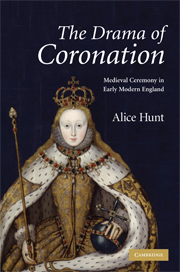Book contents
- Frontmatter
- Contents
- Preface
- Note on style and dates
- List of abbreviations
- Introduction: the ‘idol’ ceremony of coronation
- Chapter 1 Why crown a king? Henry VIII and the medieval coronation
- Chapter 2 ‘Come my love thou shalbe crowned’: the drama of Anne Boleyn's coronation
- Chapter 3 ‘But a ceremony’: Edward VI's reformed coronation and John Bale's King Johan
- Chapter 4 ‘He hath sent Marye our soveraigne and Quene’: England's first queen and Respublica
- Chapter 5 ‘A stage wherin was shewed the wonderfull spectacle’: representing Elizabeth I's coronation
- Epilogue: ‘Presume not that I am the thing I was’
- Notes
- Bibliography
- Index
Preface
Published online by Cambridge University Press: 22 September 2009
- Frontmatter
- Contents
- Preface
- Note on style and dates
- List of abbreviations
- Introduction: the ‘idol’ ceremony of coronation
- Chapter 1 Why crown a king? Henry VIII and the medieval coronation
- Chapter 2 ‘Come my love thou shalbe crowned’: the drama of Anne Boleyn's coronation
- Chapter 3 ‘But a ceremony’: Edward VI's reformed coronation and John Bale's King Johan
- Chapter 4 ‘He hath sent Marye our soveraigne and Quene’: England's first queen and Respublica
- Chapter 5 ‘A stage wherin was shewed the wonderfull spectacle’: representing Elizabeth I's coronation
- Epilogue: ‘Presume not that I am the thing I was’
- Notes
- Bibliography
- Index
Summary
The image on the jacket of this book is known as ‘The “Coronation” Portrait of Queen Elizabeth I’. It marks this book's starting point: Elizabeth I and her contested coronation ceremony in Westminster Abbey on 15 January 1559. The portrait is remarkable for being the only formal coronation portrait of any Tudor monarch to survive. It was painted by an unknown artist in about 1600, and is either a copy of an earlier coronation portrait or was commissioned at the end of Elizabeth's reign. In either case, this painting chooses to remember Elizabeth as the young, newly anointed queen she once was and recalls a ritual of transformation. The survival of ceremony in Reformation England is the subject of this book. Moving backwards from Elizabeth, it examines the coronation ceremonies of four of her predecessors. Since there are very few visual records of Tudor coronations, the book considers how these rites have been described and represented in words, from court documents to pageants and plays.
This book began as a doctoral thesis and I would like to acknowledge and thank my supervisor Tom Healy for his unfailing support, guidance and encouragement. For reading and commenting so thoughtfully on all or parts of the book, at different points, I'd like to thank Tom Betteridge, Patrick Collinson, Harriet Jaine, Louisa Joyner, Ita Mac Carthy, Gordon McMullan, Toby Mundy, Kiernan Ryan, Richard Scholar, Charlotte Scott, Greg Walker and Anna Whitelock.
- Type
- Chapter
- Information
- The Drama of CoronationMedieval Ceremony in Early Modern England, pp. vi - viiPublisher: Cambridge University PressPrint publication year: 2008

